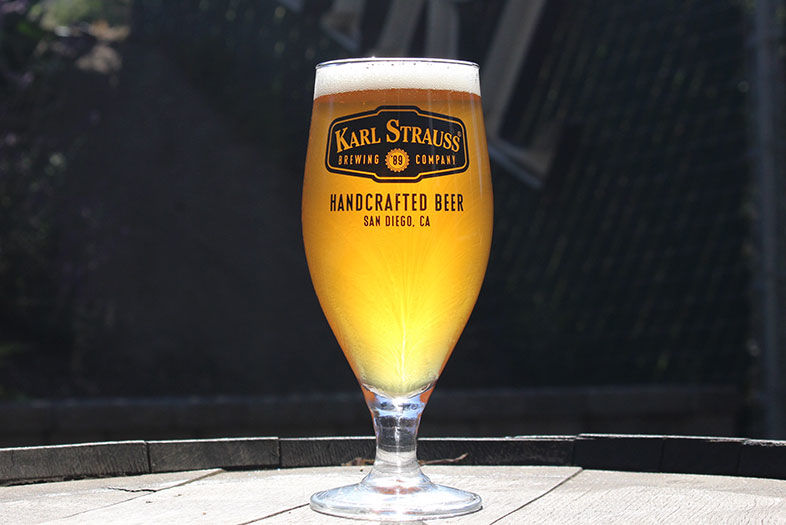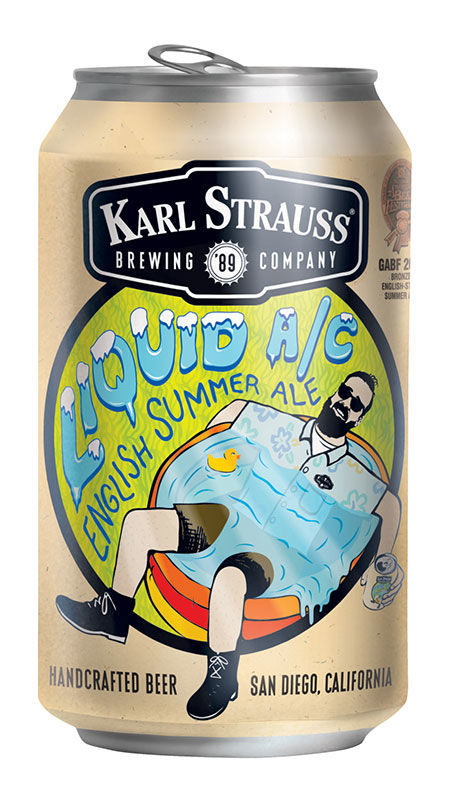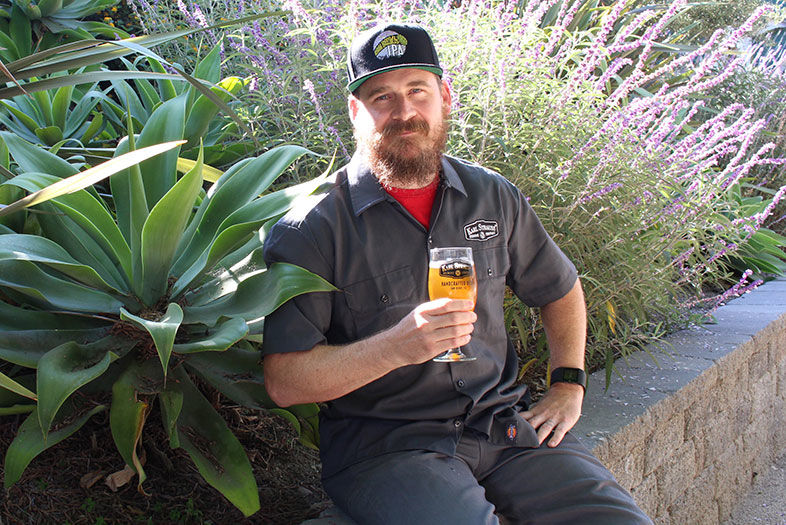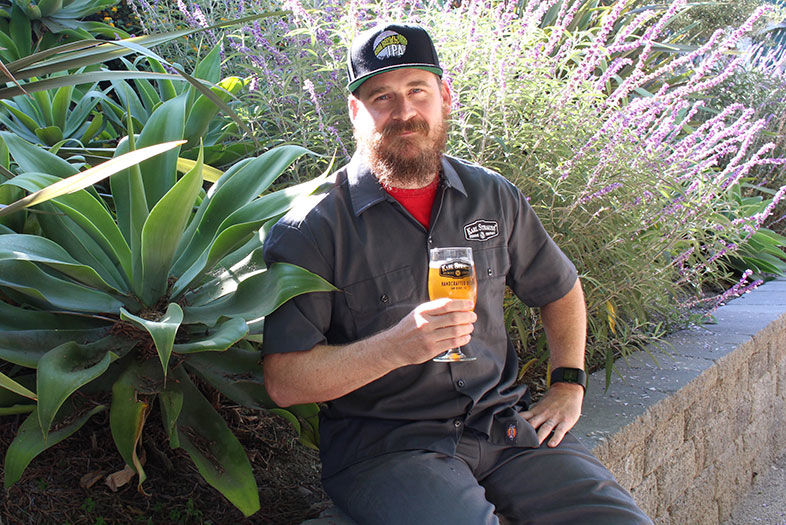It wasn’t long ago that Karl Strauss’s brewpubs were each given the task of regularly brewing a specific beer (or beers) at that location. Eventually, the brewers at those brewpubs started to ask for the freedom to do more experimental things, to create and brew new recipes, and to explore styles and techniques that had previously been off-limits. KS management said yes to that freedom, and now they’re really glad they did.
Since 2009, Karl Strauss Brewing Company has won 103 medals in major competitions. Many of those were the result of beers developed on small systems at their brewpubs—now collectively called the Small Batch Program. Aurora Hoppyalis, first brewed at the La Jolla location, won bronze at the Great American Beer Festival in 2015. Mosaic Session IPA, first created by Head Brewer Sean Albrecht at the Columbia Street (downtown) location, has won numerous medals—both it and Liquid A/C, an English-style summer ale also developed in La Jolla, won bronze at GABF 2016. In fact, Karl Strauss won enough medals at that festival it was awarded Mid-Size Brewing Company of the Year.
Head Brewer Lyndon Walker oversees the small batch program for Karl Strauss (among other things) and has had a direct hand in creating both Aurora Hoppyalis and Liquid A/C, two of the brewery’s recent hits. Laid-back, friendly, and quick to smile, Lyndon’s straightforward style seems to be the perfect embodiment of the accessible, refreshing, and perfectly balanced beers he helps to create.
I sat down in the Pacific Beach tasting room with Lyndon to talk about how new beers are developed, the current dynamics of Karl Strauss’s vibrant and varied small batch program, and how he went about creating his recipe for Liquid A/C (a frosty pint of which I just happened to have in front of me) on the small system in La Jolla.
Let’s start with a little background. How long have you been at Karl Strauss and how did you wind up here?
I’ve been here for a little over eight years, and before that, I worked at Firehouse, which was kind of a good way to get into the industry. I was going back to school and working as a bartender and had a catering job. I actually needed another job to add to all those part-time jobs. I saw a job listed at a brewery and thought I really want to get in there, so I kept going back until they hired me. I was a homebrewer, but my first job was sweeping floors and washing kegs. I learned about how a brewery worked and a lot about what not to do. I worked there for two years and it became full time after a while. Then I heard they were hiring at Karl Strauss, so I applied and got a job on the bottling line, since I had experience. I think at the time it was kind of hard to find someone with experience on the bottling line. Eight years ago there weren’t as many breweries out there, and certainly not as many packaging. So that was my “in” here. Eventually I moved up to assistant brewer, then brewer one, brewer two, and then head brewer.
You developed the recipe for Liquid A/C, which won a medal at the last GABF, but the story of how you developed it is a bit unusual, right?
I don’t usually brew beers this way, but I brewed this one specifically for GABF. It was around this time of year, when you have to decide what you’re going to make. It was hot, and I started going through all the GABF style guidelines, just cruising through them looking for a beer I wanted to drink. Then I saw a category called “English-style summer ale,” which I had actually never heard of before. I looked at the ingredients and what it’s supposed to taste like and I decided I wanted to make that beer.

Have a Beer with Karl Strauss Head Brewer Lyndon Walker
Liquid A/C is an English-Style Summer Ale that won bronze at GABF. | Photo by Bruce Glassman
What are some of the specifics of that style that are different from, say, a blonde ale?
The English yeast strain is the main thing. And then toasted, or torrified, wheat is in there, and you get a really balanced character with the malt and the hops. I’m used to just making really hoppy beers and that’s most of what I do. It’s also what I like. So here I was trying to branch out and do something a little bit different, but still have it be something I wanted to drink.
So you’d never had an English-style summer ale before? You’d never drank one and thought, “Wow, I want to make something like that”?
No. I just kind of imagined what it would taste like.
Are there any other breweries that you know of doing that style?
I looked at who had won in this category before and there were none around here. It looked like Ska Brewing had done really well with it, but that was pretty much it. I looked online at what other people said about it and what it was like, and then I looked for ingredients that would make it taste like that. So it was designed for the competition.
But you really designed it and brewed it totally blind, meaning you hadn’t had any previous experience with it and hadn’t tasted a bunch of similar beers from other breweries.
Yeah. I pictured it kind of like an ESB, but without all the caramel stuff—I toned that down and tried to get it to be more refreshing and easy drinking. You can taste the malt [Golden Promise base] and the hops and the yeast, but no one single component of it really stands out. The result is really flavorful in the way that the ingredients combine.
So you pulled together a bunch of ingredients for this that you don’t normally use?
That’s what I love about brewing at the pubs: I can get whatever I want and try it out. I can use different base malts, toasted wheat, whatever. And for this I just tried to match what it said it should taste like on the style guidelines.
And your first shot out of the gate, you won a medal.
Yeah! It got a bronze! I’ll take it!
You’ve been involved in a bunch of beers that have won medals; this wasn’t the first.
No. From here in PB we’ve made beers that have won, and at the La Jolla location I brewed beers that won bronze the year before and the year before that. So third place is kind of my zone!
Liquid A/C has become a popular beer now, so are you guys going to be brewing it more often?
We’re scaling it up. We brought it back for now because, after it won, everybody wanted to try it. We’ll be bringing it back again later this summer, in cans, but after that we’ll have to see. With the word “summer” in the name, it lends itself to being a seasonal release.

Have a Beer with Karl Strauss Head Brewer Lyndon Walker
Can release is planned for later this summer.
Let’s talk a little bit more about the small batch program. It’s gotten bigger over the years, obviously.
Well, every time we open a brewpub it has a brewery in it, too, along with the restaurant. So, as we’ve opened more [there are currently 10], the small batch program has grown. It has also evolved into being more experimental than it’s been in the past. When I first started, what we made was much more controlled—for example, La Jolla was supposed to make hefeweizen. Eventually, we and all the other brewers started asking to make a bunch of different beers, and the program got opened up. It took a while; it was a slow process, and there were a lot of people involved. It took a while to trust everyone to make the right stuff, to execute it properly and not come up with a lot of bombs. But once we started trying it a little bit, that really wasn’t a worry. The beers from the brewpubs were mostly hits. Everybody likes the beers from a specific location, and the brewers are in touch with what the people in each area like and want to drink.
What do you think having a robust small batch program does for the company overall?
From the brewer’s perspective, I think it helps to keep brewers engaged. It keeps you being creative and happy, instead of being like a factory worker. You also have a chance to have a say in what gets brewed and to make decisions, which is important in retaining people. It’s a perk. And then for the company as a whole, to have all these different beers—we brewed 137 different beers last year!—is really a great thing.
Is all the small batch brewing nontraditional creative stuff now?
There are certain times when you have to brew something for an event and there’ll be some kind of a limitation on what you can brew, but mostly it’s whatever you want. There’s GABF and World Beer Cup, so there we want to try to brew something that will have a chance—don’t go too crazy. And then there are collabs, like [Karl Strauss LA’s] Hoppywood & Bine, which was done for LA Beer Week with Hopped LA, or a beer we’ll do with firefighters in Costa Mesa. Mostly, though, the brewpubs are an R&D type of thing. We recently had a discussion about hazy IPAs. What do we think about them? Do we care? Do we want to make them? So we opened it up to everyone in the pub program and said if you want to make one, then make one. And we’ll see if something comes of it. If one of them is great and stands out, then maybe there’s something we can do with that.
And so a bunch of folks made them?
Everybody pretty much jumped in and wanted to do one! If we’d told them they had to, they probably wouldn’t have, but we told them you can if you want to. It worked pretty well! We got a bunch of different versions and lot of info pretty fast on what a bunch of different yeasts would do, and also how different additions of the rolled oats versus the golden oats versus using wheat work to get the haze. We also figured out whether we want to use the Vermont yeast or the London III. If we were going to try all those versions out here in the main brewery, it would be a nightmare, but we got the pub program to tackle it all at once.
How do you go about approving a recipe to be done at one of the brewpubs? Do you look at a recipe and the style and say yes or no based on that?
Yeah. Unlike Liquid A/C, it’s almost always something someone’s made before, so you have a good idea of how that’s going to work. We look at tasting notes and judge’s notes from previous years as well and use those, too.
I imagine there’s a bit of a healthy competition you see among the brewers from the brewpubs—each trying to come up with the next big winner. Does that keep them hungry and inspired, do you think?
Yeah, that does help. Everybody wants to make the beer that’s the “next big thing,” that everybody likes and gets the most buzz around here. I really hope the small batch program stays as it is, and we keep it as open as it is, giving every brewer the freedom to do whatever they want at the brewpub. I think the creative freedom is really important—especially important if we want to come up with the “next thing.” That’s how it’s going to happen. And it keeps people happy!

Have a Beer with Karl Strauss Head Brewer Lyndon Walker
PARTNER CONTENT
Lyndon Walker is Head Brewer for Karl Strauss. | Photo by Bruce Glassman















